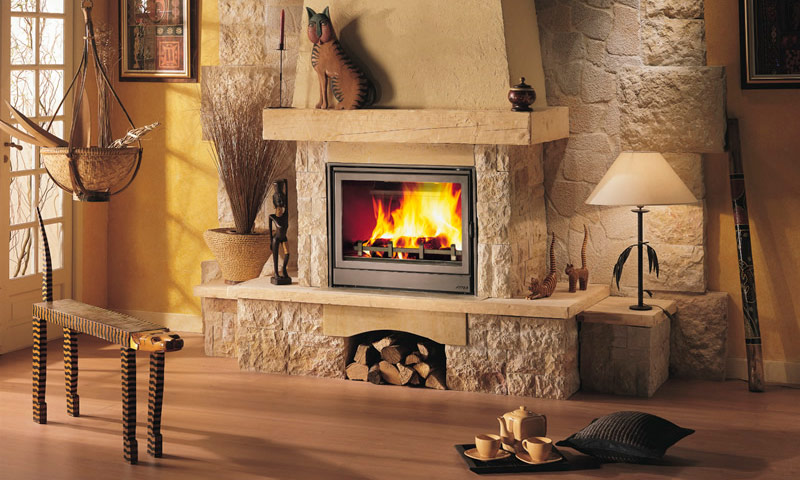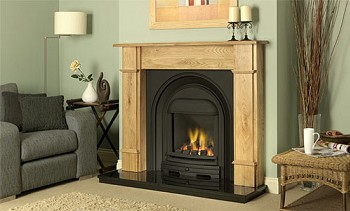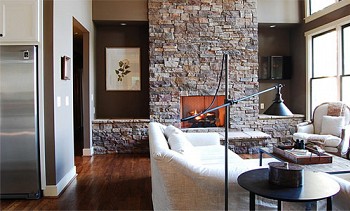A good fireplace is not just a device for heating a room - it is often a massive structure that becomes a central part of the interior. Although a burning fire always attracts attention with an endless play of flames, the appearance of the hearth itself is no less important: built-in, wall, island or corner, in a classic version or one of the modern styles - these are just some types of fireplaces from which you can choose the right one model. In addition, you still have to decide on the type of fuel and the design of the furnace - the energy efficiency of the entire system will depend on them.

Content:
Variety of fireplaces by type of fuel used
The choice of one of the following models will be determined primarily by the presence and cost of a certain type of fuel in the region, as well as by the place of installation of the fireplace - a country house or apartment. Another important point is the stage of repair of the premises - if it is only planned, it is quite easy to take into account the fireplace in the estimate, and if the repair work is completed or their implementation is undesirable, then it will be problematic to install a fireplace with a chimney here.
Wood fireplaces
The biggest difficulty in installing them is to correctly make a chimney, on which the strength and stability of the traction depend. If it is too long, they will quickly burn the wood. If short - smoke and soot can enter the room due to insufficient air flow. As a result, specialists should be involved in the calculation and installation. The ideal option is when the hearth is laid during the construction of the house, but if necessary, you can always find a solution to add it to an existing structure.
The remaining details of such a fireplace are a firebox and a portal. In the classic version, the furnaces are made open, when only a few tens of centimeters of space separate the fire from the room.

Closed furnaces are considered more energy efficient and safer to use - between the fire and the room a door is made of tempered glass or ceramic, which withstands temperatures up to 800 ° C. Some manufacturers use the technology of "clean glass", which prevents the appearance of soot.

Refractory bricks, ceramic blocks are used as the material for the furnace, or a finished construction made of cast iron or heat-resistant steel is used.
The portal is the “face” of the hearth - it includes all the external structural details that set the tone for the entire appearance of the fireplace. Depending on the design of the furnace (proximity to fire), materials such as marble, granite, brick or sandstone are used to create the portal, and in some cases, panels made of precious wood (oak, maple, etc.) are also used.
Gas fireplaces
In addition to the design of the furnace, these fireplaces are not much different from wood-burning ones - they also require a well-made chimney, but they can only work when connected to a gas main (methane - natural gas). There are mobile fireplaces, which are relatively easy to move from room to room, and if necessary, quickly heat one of them. They can work either from a gas cylinder (on propane-butane), or for such models they conduct separate piping of the gas pipeline, which can be connected in different parts of the house.
The advantages of gas fireplaces include quiet operation, the fastest kindling, ease of operation and a high level of fire safety.

Electric fireplaces
In fact, this is an ordinary electric heating device, but stylized as a hearth. Since an open flame is not used here, a chimney is not required and in general the use of such a device is much simpler - this fireplace will work wherever there is an electrical outlet and it will warm up to a working temperature for a couple of minutes.

Such fireplaces are made in a classic floor-mounted version or as wall-mounted devices - their thickness in this case is approximately the same as that of a TV with a liquid crystal screen.

To resemble a natural hearth, manufacturers use various methods to simulate a burning flame or glowing coals - the OptiFlame effect, which uses air-blown silk ribbons with special lighting, is the most realistic.
Additional advantages of electric fireplaces are the possibility of using a thermostat that automatically regulates the temperature in the room, as well as air filters that trap dust particles up to 1 micron in size. The latter function was appreciated by allergy sufferers and just those buyers who monitor the cleanliness of the air in the room.
Biofireplaces (ecofireplaces)
These fireplaces use such fuels that practically do not emit carbon dioxide (bioethanol or ethanol) during the combustion process, so they do not need a chimney, and enough air is available to maintain the flame, which enters the room due to normal ventilation.
For full heating of the entire building, the capacity of such fireplaces is not enough, but they are a spectacular addition to the main heating. Firstly, this is the presence of live fire, and secondly, all 100% of the thermal energy that is obtained during its combustion is consumed precisely for heating the room, without heat loss, which in ordinary foci leaves through the chimney.
Typically, such fireplaces are made small and are either built into the wall or installed in an open way. The design and shape of such devices is ideally suited to modern interiors such as "modern" or "hi-tech". Another of their advantages is that these are almost the only permitted types of fireplaces for an apartment that use live flame.

Comparison of different types of fireplaces
 |  |  |  |  | |||||||
|---|---|---|---|---|---|---|---|---|---|---|---|
| Wood burning with an open firebox | Firewood with a closed firebox | Gas | Electric | Bio fireplace | |||||||
| Heating time | Heating occurs only at the time of burning, about 6 hours. | There are cyclic (5-8 hours) and round-the-clock burning. There are varieties of heat storage. | About 8 hours. | Only during operation. | Only during fuel combustion, 1 kg burning time. - 2-5 hours | ||||||
| Heating area, m2 | No more than 40. | 60 to 300. | 40 to 60 | Up to 25. | Up to 15. | ||||||
| The efficiency of the focus,% | 5 - 40 | 60 - 85 | 60 | 5 | 5 | ||||||
| power, kWt | From 6.5 | 6 to 30 | 4 to 6 | In heating mode to 2, in simulation mode - 0.04 | About 2. | ||||||
| Where to install | Typically in private homes. Perhaps in an apartment where there is a chimney. | Typically in private homes. Perhaps in an apartment where there is a chimney. | In private homes. | In any room. | In any room. | ||||||
| The need for coordination with the fire service | Required. | Required. | Required. | Not required. | Not required. | ||||||
Varieties of fireplaces by installation method
According to the installation method, fireplaces can be divided into built-in, wall, corner and island. Each of these solutions has its own advantages and disadvantages, and the choice of any of them depends on the availability of space in the room and interior preferences.
Built-in fireplaces
The most economical option in terms of space - such models are built into the wall or made in the form of a column, the lower part of which is a firebox, and the upper one is a chimney.
In terms of installation, this fireplace is good if its design is already incorporated into the project of the house. Otherwise, during installation, it will be necessary to chop the walls for the hearth itself and additionally lay a chimney. Moreover, it is far from a fact that everything will be possible to do exactly in the place where you want to install the fireplace.If the wall thickness is insufficient, then labor costs may be greater than in the case of mounting a model of a different design.

Wall Fireplaces
This model is not suitable for small rooms, since all its elements are located in the room against the wall. Given that it is additionally required to construct a heat-resistant floor, the entire structure completely protrudes beyond the contour of the wall.
Despite its size, the wall model is one of the most common for heating with wood or gas, as its design allows installation in an already built house.
The methods of external decoration are not limited by anything - a brick, various types of stone or ceramics are used for it.

Island fireplaces
The main advantage of such models is the original design, but in terms of energy efficiency they significantly lose to other types of fireplaces - their heat transfer is about the same as that of a lighted fire.
Structurally, island fireplaces are a heat-resistant platform made on top of a standard floor covering. Its perimeter is made with or without glass barriers to create the effect of a completely open fire, but in the latter case, handling the fireplace requires extra care.
A smoke collector is mounted above the hearth, which connects to the chimney. The overall dimensions of the entire structure are large enough so that it can be used without interference in small and even medium-sized rooms, which must be taken into account before deciding on it.


In addition, there are island fireplaces that are suspended in the room and do not touch the floor. They have a special design and are often used in the interior made in the Scandinavian style.

Corner fireplaces
By right, such types of fireplaces for the home are considered one of the most beautiful and popular. The advantages of this solution in a smaller amount of occupied space and a more convenient location - in the corner, the hearth in any case does not interfere with movement around the room.
When erecting such a fireplace, the chimney can be placed on any of the walls to which it adjoins, and the walls of the combustion chamber are made either in the old fashion - an inclined shape, or a more modern solution is used - a two-chamber firebox.
The angular arrangement of the fireplace has practically no effect on the possibilities of its design: concrete, stone, brick can be used here - just like when decorating other types of fireplaces.


What are the fireplaces depending on the method of heat radiation and the design of the furnace
Here the main difference lies in the number of sides where the hearth gives off heat from the firebox - only in front of you or in different directions. It can be said simply - the number of sides of the fireplace is determined by the number of places from which you can see the fire in the furnace.
Unilateral
This is the simplest and most common design which is characterized by high heat transfer due to the inclined walls of the furnace. They reflect the thermal energy received from the fire, which is removed through the main window of the furnace and warms the room.

Bilateral
Such fireplaces may include corner, island and some wall models, in which two adjacent or opposite sides of the firebox are transparent.
Most often, such a model is chosen because of its original appearance, but before choosing a fireplace with a two-sided fireplace, it is necessary to take into account its inherent disadvantages:
- The chimney should be designed for greater traction, because the fuel will burn faster. Accordingly, there will be increased ventilation requirements for the room.
- Since there are fewer reflecting surfaces inside the furnace, the amount of heat that enters the room is correspondingly reduced - lower energy efficiency of the structure.
- Such a fireplace has not one, but two sides, which must be monitored so that a smoldering ember does not fall out of them. Accordingly, the area of the floor covering, which must be protected from exposure to high temperature, is larger.


Trilateral
The main plus of such a constructive solution is in design originality. In appearance, such a fireplace resembles an aquarium for a fire, which is built into the wall on one side, and a chimney is attached to it from above. It all looks really very beautiful, but it’s not without certain drawbacks - the same as those of a two-sided fireplace, only more pronounced:
- The flooring must be finished with a thermally insulating layer on three sides.
- Although the heat at such a center diverges in three directions, the main effect is felt only from the central (opposite reflective surface).
- Low energy efficiency of the fireplace.

Classification of Fireplaces by Style
According to the architectural solution, the vast majority of fireplaces can be classified as belonging to four main types: classic, country, modern and hi-tech. Each of the directions has its own individual characteristics, by which they can be easily distinguished from each other.
Classic style fireplaces
The shape of the portal of the classic fireplace is in the form of the letter “P” and has massive outlines, often with decorations in the form of columns or bas-reliefs resembling them. The material for the portal is most often marble, malachite or wood, and when erecting a fireplace in the English style, cast-iron forged parts are used - lattices, fences, etc.

Country style fireplaces
The fireplace, made in this architectural style, is easy to recognize thanks to the presence of a massive wooden beam at the top of the portal and a wide "sole", which gives the entire structure "D" - shaped shape.
Literally, the name of the style is translated from English as “province” or “village”, which implies the use of simple but effective solutions. Therefore, the material most often used for such fireplaces is lightweight, porous, and excellent heat-holding stone - “sandstone” or “shell rock” (in some regions - “shell rock”). The outer part of the chimney is most often finished with gypsum materials, which are easily processed and do not require long hardening.

Art Nouveau Fireplaces
The design of such fireplaces is based on the decisions used in the classical style, but a quick glance is enough to distinguish them from each other. If the classic looks massive and solid, then the modern foci are often more straightforward and even if the portal is decorated with bas-reliefs, they create an impression of lightness and fit perfectly into the modern minimalist interiors of offices and residential premises. This is not an obligatory sign, but most often fireplaces made in the modern style occupy the entire space from floor to ceiling in height.

Hi-Tech style fireplaces
Created in the style of high technology (this is how hi-tech is translated), a fireplace can differ from its analogues not only in its futuristic form, but also in the use of new refractory materials. The expansion of industrial capabilities in processing and compounds in various combinations of glass, metals, periclase, chamotte, concrete and even plain water, has led to the creation of fireplaces of the most unexpected forms that will fit into any interior.
The only drawback that can be found in such solutions - it is advisable to carefully study the proposed design - the laws of heat distribution are the same everywhere and the original appearance of the fireplace is sometimes reflected for the worse in its efficiency.



